Posted by
Soumya Banerjee
on
September 07, 2015

The boma in Chattisgarh’s Udanti Wildlife Sanctuary has a unique resident- Asha, one of Central India’s last wild buffaloes. At first glance, she looks strikingly similar to her domestic kin, but a closer inspection reveals the massive spread of her horns
and huge bulk, which are unmistakeable characteristics of the wild buffalo.
Asha’s proud ancestors would once have roamed across much of Central India and Northeastern India. The eminent hunter-naturalist Dunbar-Brander, writing in the 1920’s, wrote of their abundance in the forests east of Balaghat, with their biggest stronghold
being Bastar.
Unfortunately, the wild buffalo’s range and population have undergone a massive contraction since. A survey in 2007 by the NGO
Wildlife Trust of India (WTI), estimated their total population in Central India as being less than 50 individuals. Indravati, home to the largest population ( of about 25-30 individuals) ,
was in the grip in left-wing extremism, and hence, no conservation programme could be taken up there. Udanti in Raipur district was found to have 7 wild buffaloes, of which only 1 was female. The decline has been particularly steep in recent times, since in
1993, Chattisgarh itself was believed to be home to around 250 buffaloes, with both Indravati and Udanti having approximately 100 individuals each. Healthy populations of these giant bovines continue to exist in quite a few Protected Areas in the Northeast,
such as Kaziranga, Manas and Dibru Saikhowa in Assam,
Balpakram in Meghalaya and Dayang Ering in Arunachal Pradesh.
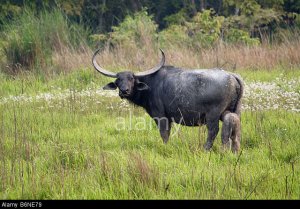
A wild buffalo with its calf in Kaziranga National Park.
Pic : alamy.com
However, many of the Northeast’s 3000-3500 wild buffaloes are believed to have been adversely affected by interbreeding with their domestic kin, and the remaining populations are also threatened by the destruction of their wet grassland habitat and poaching.
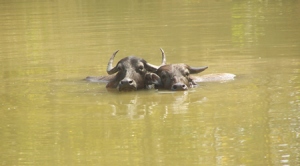
Asha, with one of her calves, at Udanti.
Pic : Dr R.P Mishra, WTI
WTI, with the assistance of the Chattisgarh Government, swung into action immediately. A “Wild Buffalo Conservation Project” was framed. Conservation initiatives could be undertaken only in Udanti, as it was the only habitat of wild buffaloes which was free
of naxal violence at that time (sadly, naxals have extended their control over much of udanti, and neighbouring sitanadi, since 2009-10. However, attempts to conserve the wild buffalo continue).
Given the very low population in Udanti, conservationists were determined to prevent any unnatural deaths, which could lead to the extinction of the population there. A “boma”- an artificial enclosure was constructed for the last female buffalo of Udanti,
aptly named “Asha”, or hope. She has given birth four times since. Conservationists, however, could truly rejoice only when she gave birth to a female calf, named “Kiran” for the first time earlier this year. Her previous three calves had all been male. The
male calves grew up in the boma with her, before joining the herd, which spends most of its time in an adjoining grassland, with some boisterous males frequently visiting the adjoining villages to mate with the female domestic buffaloes there.
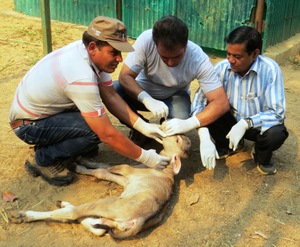
One of Asha’s calves gets a health check-up.
Pic : Dr R.P Mishra, WTI
Not wanting to take any chances, Karnal-based NDRI (National Dairy Research Institute) cloned Asha in January 2015, producing a female calf named “Deepasha”. These three females represent the last hope for Chattisgarh’s beleaguered wild buffaloes. Asha herself
is 13 years old, and a female wild buffalo is normally reproductively viable for about 15-17 years of her lifespan, which is usually 20-22 years.
Even though administrative apathy and a steady rise in naxal presence in the surrounding forests have stymied initiatives, several attempts have nonetheless been made to preserve the buffaloes of Udanti. These involve the inoculation of livestock residing
in fringe villages, the deweeding of grasslands, and the providing of incentives to villagers encouraging them to sell off domestic buffaloes, so that interbreeding between domestic and wild buffaloes, leading to a contamination in the genetic stock of the
latter doesn’t occur. Attempts are also being made to procure genetically pure wild buffalos from the Northeast to boost Udanti’s tiny population.
In spite of so many measures, however, the path ahead is still treacherous.
In 2009, a tiger reserve, covering 1,842 sq. km (with a core area of 851 sq. km) was eked out of Udanti and adjoining Sitanadi wildlife sanctuary. The Udanti-Sitanadi tiger reserve suffers from several management lacunae, however. These include a highly
complex administrative set-up which is not conducive to tiger conservation, with the Field Director’s office being located in distant Raipur. Moreover, protection infrastructure such as anti-poaching camps and vehicles for patrolling, is severely lacking.
The DFO’s managing these sanctuaries are often burdened with non-wildlife conservation related tasks, dealing with the management of the surrounding territorial forests. A massive overhaul of the protection mechanisms currently in place need to be carried
out by the State Government.
This will be very hard to carry out, however, given the ongoing naxal insurgency in the landscape. Udanti-Sitanadi should not be written off, however. Along with the contiguous Sunabeda-Khariar forests in western Odisha, it forms part of a compact forest
block extending over 3000 sq. km, which serves as an important habitat for many species of Central Indian flora and fauna. Proposals to denotify such “lesser” forests are based on a poor understanding of their ecological potential, and should not be acted
upon.
Tigers with cubs have been reported from Udanti and surrounding forests in recent times, and, for the first time, a tiger was camera trapped in 2014, an event which put to rest niggling doubts regarding the presence of tigers in the landscape.
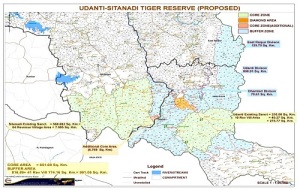
A map of the Udanti-Sitanadi Tiger Reserve.
Pic : cgforest.com(Chhatisgarh Forest Department)
Attempts have also been made to conserve the other viable population of wild buffaloes in Central India, in the Indravati landscape. Indravati itself may be out of bounds to the Forest Department, but neighbouring Kolamarka, in Maharashtra’s Gadchiroli
district, frequently plays host to a couple of herds. A 181 sq. km area in Kolamarka was declared a conservation reserve in 2013, for the conservation of wild buffaloes. Inspite of recurring incidents of naxal violence, a dedicated team, led by RFO Atul Deokar,
have been diligently monitoring the wildlife of the region, while undertaking numerous conservation initiatives with the help of the local villagers. Kolamarka is also an important habitat for Maharashtra’s state animal, the Indian giant squirrel (
Ratufa Indica). To sustain these initiatives, support from the State Government is key. Kolamarka’s forests are threatened by habitat destruction and poaching, and conserving the small wild buffalo population here (estimated at around 10-15 individuals),
will be a stiff challenge.
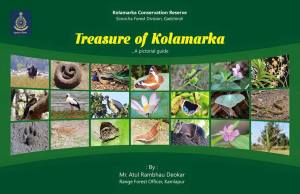
“Treasures of Kolamarka”-a book detailing the biodiversity of Kolamarka conservation reserve in Maharashtra’s Gadchiroli and is a product of the untiring efforts of RFO Atul Deokar and his team.
Pic : RFO Atul Deokar
Of late, the Central Government has also taken an interest in wild buffalo conservation, with the buffalo being one of the five target species for which recovery programmes have been implemented. Moving these plans from the cramped confines of the bureaucrat’s
office to the field in the badlands of Udanti-Sitanadi is of the utmost essence.
The Central Indian wild buffalo has never received the same amount of conservation support as the tiger or the elephant, with the result that it is poised on the brink of extinction in a region that was once its historical stronghold.
Asha, the last adult female of Udanti, embodies the hope that the noble bovine will recover from the brink of extinction, and reclaim those forests which they once lorded over.
|
Posted by
Soumya Banerjee
on
August 30, 2015

After filling up our boat with foodstuffs and water, we – myself, two forest guards, the owner of our launch, and his assistant, bid adieu to civilisation, leaving the small town of pakhiralay (located opposite to the entrance to sajnekhali wildlife sanctuary)
far behind, as we journeyed into the heart of the throbbing wilderness that constitutes the Sunderbans Tiger Reserve. This reserve, spread over 2,585 sq. km, is the only place in the world where wild tigers exist in a mangrove habitat. We were participating
in the initial phase of the quadrennial tiger census carried out by the NTCA (National Tiger Conservation Authority).

The world’s only mangrove tigerland.
Enumerating wildlife scientifically involves demarcating “transects”, or pathways, in the forest and then noting down signs and direct sightings of the various species which are encountered while the transect is being negotiated. In the sunderbans, the various
transects coincide with the innumerable creeks which dot the mangrove forests.

A map showing the transects in Panchamukhani block of Sajnekhali Wildlife Sanctuary, STR.
Our transects lay mostly in the Panchamukhani and Pirkhali forest blocks, a part of the 362 sq. km Sajnekhali Wildlife Sanctuary, which forms the north-western part of the Sunderbans Tiger Reserve.
We had to fill up several forms stating the time and GPS location of each of our sightings of the various species and their signs. At half-hour intervals, we also had to state details of the flora noticed- the various mangrove species encountered, how tall
they were, etc.
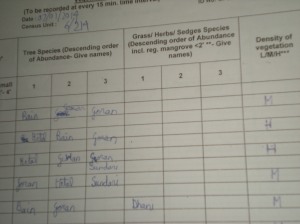
Such sheets needed to be filled diligently!!!
We negotiated each river bend in extreme caution, hoping to spot tigers at the very next one. Unfortunately, the big cat itself remained elusive. But tiger pugmarks were everywhere-we even saw the pugs of a tigress and her three cubs at a riverbank. Another
set of pugs appeared to belong to a mating pair. These are the welcome signs of a thriving population.

Pugmarks left by the king of the mangroves.
Not that this population isn’t affected by any threats, though. Man-animal conflict is a significant problem in the Sunderbans, for this is an ecosystem where man is still preyed upon by quite a few species- the Bengal tiger and the estuarine crocodile being
the foremost among them. We saw two crocodiles during our boat survey, however, they were extremely wary and rushed into the water as soon as they saw us.

An estuarine crocodile basks in the sun opposite the Nature Interpretation Center at Sajnekhali.
The vast majority of those who get killed by tigers and crocodiles in the Sunderbans are honey-collectors and fishermen. Crab fishing often yields fair returns, but it is an extremely dangerous occupation, which, sadly, the poorest of the poor have no option
but to take recourse to. Numerous ecodevelopment initiatives have been launched by the authorities in the fringe areas of the Sunderbans in the recent past; however, many people continue to remain heavily dependent upon the forest. Sometimes, poachers sneak
into the reserve in the guise of crab fishers. While the direct targeting of tigers for their skin and bones has never been a common occurrence in the Indian sunderbans, there should be no let up in vigil.
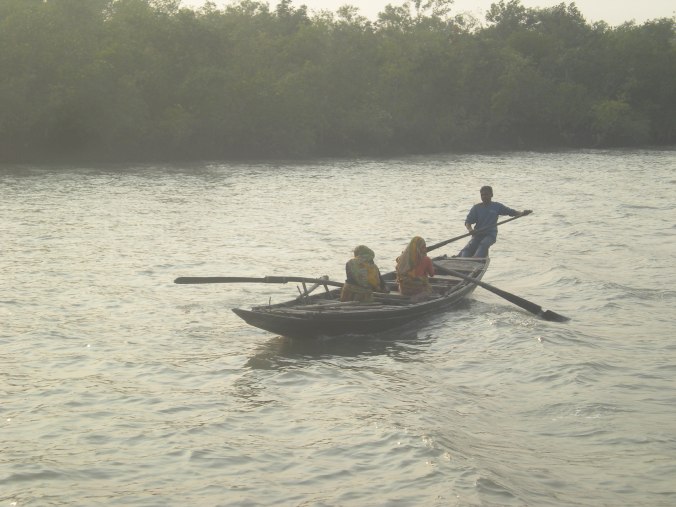
The fisherfolk of the Sunderbans.
Naturally, there are few permanent residences for the forest staff of the Sunderbans which lie on terra firma. Several boats have been converted to “floating anti poaching camps” , for more effective patrolling. Nevertheless, the average age of a forest
guard in the Sunderbans is 52 years, and several posts lie vacant.
After having met no humans during the first day of our survey, we stopped at the first floating camp we came across on the second day. The guards there told us that a tiger had crossed the creek where the camp lay only half an hour ago. And sure enough, we
saw his huge saucer-shaped pugmarks on the opposite shore.
Our next encounter with Homo sapiens was of a different kind, for a boatload of tourists chanced upon us, as we were headed off towards our next transect. They initially thought that we were an errant tourist-carrying boat that had strayed into a
part of the forests where tourists are forbidden to go!!!
On that very same transect, we came across a small herd of chital- some 4-5 members of the group were visible. Chital, or spotted deer, form the bulk of the tiger’s preybase in the sunderbans. Chital sightings in sunderbans are few and far between, since they
are heavily reliant upon the few fresh-water ponds which exist on the Sunderbans. Poaching for meat has also played a significant role in depressing their density, which, at 13.3 per sq. km (according to a WII survey), leaves a lot to be desired.
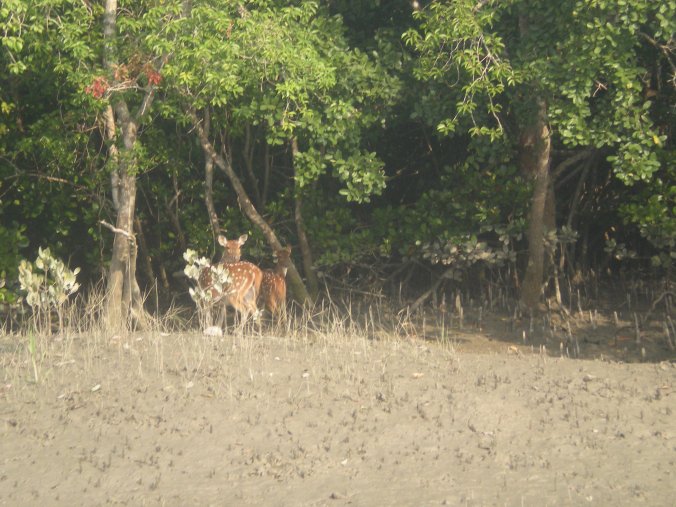
Chital form the bulk of the tiger’s preybase in the Sunderbans.
Tigers in the Sunderbans also prey on rhesus macaques, wild boar(of which there are few), and monitor lizards, some of which can grow up to 7-8 feet in length.
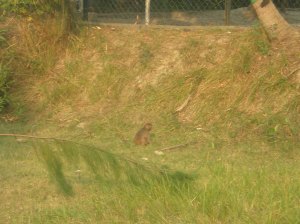
Rhesus macaques are commonly seen at Sajnekhali.
After 3 days, the hectic census finally came to an end, with our sheets full of data regarding the time and GPS location of each sighting of wildlife and their signs. Even though i am a novice birdwatcher, i was able to identify common sandpipers, great
egrets, ospreys, purple herons, golden orioles and 4 species of kingfishers- black-capped, brown-winged, small blue and white breasted, among others. The Sunderbans, with over 230 recorded species of birds, is a dream destination for a birdwatcher.

A common sandpiper.
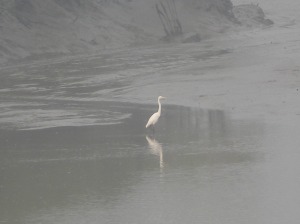
Great egret (Ardea Alba).
The results of our hard work were made available a year later- 76 tigers were estimated to exist in the Indian Sunderbans, compared to 70 in 2010. The need of the hour is to strengthen conservation initiatives in the Sunderbans, especially when it comes
to patrolling and monitoring. The mangrove tigerland, with its enchanting habitat, fierce tigers, lurking crocodiles, and soaring egrets is a unique component of our natural heritage which deserves to be jealously protected forever.

Postscript : This article is a tribute to Panchanan Mondal and Ghosh Babu, those awesome forest guards whom i accompanied during the census, and whose dedication and knowledge was a source of inspiration. These brave foot soldiers of the Sunderbans
are doing a wonderful job in possibly the most inhospitable tiger landscape in the world- serving with dedication day in and day out, inspite of having lost colleagues to tiger attacks in the past.
I also thank Joydip and Suchandra Kundu, eminent Kolkata-based conservationists, for their help and support, and Subrata Mukherjee, the then field director of STR, and his team. May they receive all the support they so earnestly need, in their war
to protect the mangrove tigerland.
|
Posted by
Susan Sharma
on
August 29, 2015

I watch with interest the large number of morning walkers on the walking path so well carved out along the
cleaned part of the Ulsoor lake. Some are engaged in conversation, most glued to the earphone, some exercising, some playing ball in a clear strip. Cormorants splash around in the clean part of the lake, obviously there are fish in the water. Their splashes
arouse the curiosity of walkers who are new to the area. Mobile phones go clicking. Pariah kites circle around. A single Brahminy kite stands out. The number of Brahminy kites seems to have gone down. I could spot only one in about ten days' time.
This blog is for all of those who do not have time/inclination to watch the lovely butterflies and other insects they pass by every day. These insects are becoming rarer by the day and we in India are lucky that spraying of insecticides is not that widespread
yet so as to kill them off for ever from our parts. Safety tests done in labs before marketing insecticides don't account for the long term poison accumulation that kills bees, and possibly many other beneficial insects. By disregarding the threat of chemicals
to tiny creatures, scientists warn, may be endangering larger ones like ourselves.
I call them Gems, because they are priceless in today's world. Here are a few I could manage clicking.

Tailed Jay
To read more about this butterfly, go to
http://www.ifoundbutterflies.org/sp/569/Graphium-agamemnon
Common Castor
To read more about this butterfly, go to
http://www.ifoundbutterflies.org/#!/sp/765/Ariadne-merione
Plain Tiger
To read more about this butterfly, go to
http://www.ifoundbutterflies.org/#!/sp/744/Danaus-chrysippus
Silk cotton Bug
And now, the Glaring Gaps of the Lake!
To reach the walking path I had to walk along a stinking sewer which borders the Lake for almost 1000 meters. Sewage water kept spewing in from other parts of the lake as well.
The stinking sewer whose water goes into the lake

The pretty water Lilies blooming in the enclosed part of the lake did not prevent the steps of the step well getting
strewn about with polythene bags and styrofoam glasses. (Double click on the picture to see a larger image)
Marketed in the US under the name Styrofoam, EPS Expandable Polystyrene Foam (EPS) was invented by Dow Chemical scientist Otis Ray McIntire in 1941. There are two main issues that polystyrene causes for marine (read lake) animals - mechanical and chemical.
"The [mechanical root] is very straight-forward," says scientists. Oftentimes, we find polystyrene foam lodged in the intestines that causes blockages that can be lethal. If you think about how we worry about a mild blockage from eating the wrong thing, imagine
eating a ball of Styrofoam. That's what some of these animals are doing."
Chemically, absorbent properties make EPS even more dangerous. "Polystyrene foams essentially act like little pollutant sponges, picking up and concentrating some of the nastiest contaminants in the water" That's not just bad for the fish and the cormorants.
It could be bad for humans.
My earlier article on Ulsoor lake "Bringing back nature into the city of Bangalore"
can be read at the link
http://www.indianwildlifeclub.com/ezine/view/details.aspx?aid=830
|
Posted by
K.Vinai Bhushan
on
August 28, 2015
I visited Maredumilli forest in april 3rdweek 2014 ,which is 80 km from historic town rajahumdry – andrapradesh.
Theforest was very green even in hot summer. Falls were running with good amountof water. Thick forest with some good number of animals in cluding big cats.The pplace wa very cool and rainy. We have visited some water falls, coffeeplantations and a river.
We tasted the local famous bamboo biryani too. The accomidation facilities are good and atreasonable fares. Visit
www.vanavihari.com.
Regards
![]()
![]()
![]()
![]() ![]() ![]()
![]()
|
Posted by
K.Vinai Bhushan
on
August 24, 2015
I visited Maredumilli forest in april 3rdweek 2014 ,which is 80 km from historic town rajahumdry – andrapradesh.
The forest was very green even in hot summer. Falls were running with good amountof water. Thick forest with some good number of animals in cluding big cats.The pplace wa very cool and rainy. We have visited some water falls, coffeeplantations and a river.
We tasted the local famous bamboo biryani too. The accomidation facilities are good and atreasonable fares. the coordinator is very good and cooperative. Visitwww.vanavihari.com.
|
Posted by
Uday
on
August 22, 2015

Less known as tiger reserves since quiet late the park in India was made famous by the legendary Rudyard Kipling. It is said a British Officer (Lt.Moor) discovered Mowgli living among the wolves near the village of Sant Vavadi. The news got to Col.Sleeman
and then to Kipling.
Using his imagination he carved playful but adventurous life of the child and his wild entourage of the Seoni Hills. The vivid spins of imagination and entailing story that emerged made the Jungle Book immortal. The escapades enthrall and enliven the minds
of young and old. The Seoni Hills mostly under serve biotic stress harbor enchanting wildlife in small area untouched by the mauradaurs of the wild.
This is now known as Pench Tiger Reserve and National Park all over the world. Ensconced in Seoni and Chhindwara District of Madhya Pradesh in Central India the tiger-land is one of the choicest place to get to see the tiger in its natural home. A part of the
reserve is under Maharashtra Forests but most of the tourism is in the belt that lies in Madhya Pradesh.
The park is about eighty km from Nagpur Airport while the distance from Jabalpur Airport is about 200 km. The distance from Kanha National Park is about 150 km. The long drives to the reserve takes a turn at Khawasa Township on the border to the two states.
From here it is a ten km drive to Turia Gate of the reserve.
Both the long drives to the tiger reserve cut across some of the finest reserve forests creating a picturesque spectacle. The road to Turia Gate offers a chance to see the Indian wolf for those lucky enough. The big cats are encountered everywhere in the dense
canopy besides the other animals. The reserve is home to many other mammals and antelopes like the Nilgai, four horned deer and Indian Gazelle.
Tourists on tiger safari preen their eyes and alert their sensory apparatus to get a sight of the sloth bear,leopard and the wild dog. The majestic gaur is striking in appearance due to its massive musculature and sheer grace. The coarse feeder thrives in the
park thanks to excellent conservation efforts. Wild boar, spotted deer,sambar and langur are a common sight.
Pench River intersects the reserve and is dammed at Totlah Doh. This has created a large reservoir now frequented by various species of water birds. Hence the reserve is a good place to see both the wetland and forest species in Central India. The river is
a perpetual source of water and hence acts as the lifeline of the park.
The ecosystem comprises of low lying mountains, dense mixed forests, grasslands, water bodies and rivers. These elements form an excellent habitat for the tigers and major mammals. Small nocturnal mammals can be seen on the night safari in the buffer zone of
the park. Animals such as civets, mongoose, wolf, leopard, porcupine, pangolin, ratel and many more. The night safari is available throughout the year and can be booked on the MP Online Portal.
There are many resort hotels for accommodation in the buffer zone of the park near the Turia Village. The hotels at Pench National Park range from budget to star category offering accommodation at different tariff to suit the visitors.
The main tourism zone of the park is open from 1st October to end of June while the night safari is available throughout the year. Tourists visiting the park must carry warm clothed during the winter along with good set of binoculars and some bird books.
Since the gate entry is limited to set number of vehicles one should always book in advance before arrival.
|
Posted by
Uday
on
August 21, 2015

Grill and Grime sets the pace for birding in Northern India. The race begins from the T3 Airport where avid birders from far away lands arrive. The trip begins as we move towards Agra on the way to Bharatpur and Chambal
River Sanctuary. The mini bus rattles along past a quagmire of human dwellings tortuously placed in a juxtaposition. Soon we we begin rolling past the green fields and small hamlets. But not for long, for at Mathura Township we turn in the direction of Bharatpur
the avian paradise like non else where.
A fifty km drive further on will lead us to Bharatpur. The road riddled with pot holes - as treacherous as they can be - wades across a picturesque countryside. The yellow lined mustard fields are the hall mark of
this drive. The quaint hamlets are as striking as they can be. The colorful courtyards, veranda all painted in Rajasthani motifs impress my foreign visitors.
At Bharatpur we are greeted by Mr. Singh - the robust and cheerful owner of the Sunbird Lodge. The day begins with the search for avian in the fields near by the Sanctuary Gate. The search is for Indian Courser but
we also come across lot of grassland birds.
The whole day is spent in the sanctuary on foot we we come across scores of avian species. We visit extensive wetlands, mounds and dikes. The small patches of forests also yield many delights. We also visit Bund Baretha
which is about fifty km from the park. Here we score for some water birds, pipits and buntings. This is where we come across Indian Skimmer whence they come to nest.
From Bharatpur we head to Dhaulpur and visit the Chambal River Sanctuary. This is an exciting destination, and boating in one of the most unpolluted river is an experience. We come across many birds besides the marsh
crocodile, gharial and river dolphin. The long stretch of river accords an exciting boat ride in between low lying sandy hills and shores. Jackals, foxes, hyenas and wolves are often encountered in the shores with luck.
Some of the birds we come across are prinias, buntings, gulls, storks, ducks, sand grouses, falcons, eagles, owls and warblers to name a few.
We head back to Agra and then move towards Nainital. On the way we look for Sarus Cranes as well as species on the Ganges River Banks. Nainital is a hill resort but badly urbanized hence we chose Sat Taal And Pangot
up hill each at a distance of about fourteen km from the township. Sat Tal at 1400 MSL is crowded but the natural beauty of remaining forests and lakes also offers magnificent bird watching opportunity. At Sat Taal we look for Forktails, thrushes, flycatchers,
minla, leiothrix, golden robin, buntings, woodpeckers and more. A two day birding yields a checklist of more than fifty exciting species.
We climb higher to 2100 MSL in the Himalayan Foothills two reach snow covered Pangot. Our target species here are the Kokals Pheasant, Chir Pheasant, Himalayan and Eurasian Vultures, Bearded Eagle, buntings, thrushes,
tits and many more. A two day stay accords sightings of unique birds which are altitude migrants.
The drive to Corbett Tiger Reserve is a pleasant eighty km via Kaladungi the home town of legendary Jim Corbett. The avi fauna begins to change as we descend towards the plains. The fantastic tiger landscape has more
than five hundred avian species to sight. We stay at the Dhikala Complex while in the park and look for tigers and other mammals besides avian species.
The foothills are frequented by species from the plains as well as the altitude migrants from the Himalayan Landscape. We search for the Siberian ruby throat, paradise flycatchers, Niltavas, flycatchers, wren warblers,
laughing thrushes, bulbuls, nuthatches, woodpeckers and many more.
We than move to outskirts of Corbett to search for more species. The trip is full of excitement a midst tigers and elephants. We visit Mohaan, Lal Dang, river banks of Kosi, Kumeria and Sita Vani for some amazing discoveries.
The fortnight long trip ended as we headed back to New Delhi. Happy that the extensive
birding tour package organized by India Footprints was a great success. All around the tour we were assisted by local guides very familiar with the regions. We stayed at the finest lodges with great service, food and friendly staff.
Every year as winter sets in I look forward to exciting ornithological trips in India as tour leader and birder.
|
Posted by
Uday
on
August 19, 2015

A four hour drive through picturesque Umaria Forests takes one to Bandhavgarh after landing at Jabalpur Airport. Albeit one comes across lot of denuded patches the remaining low lying hills with good forest cover create
a pleasing picture. Once teeming with wilderness and forests the region has lost its sheen. Like every where else the reserve forests are slowly turning into green deserts. The wildlife is badly decimated thanks to indiscriminate poaching which still goes
on sporadically.
The long continues stretch takes an abrupt turn at Shahpura township. This place hosts the famous Ghagua Fossil National Park. The plant fossil date back to 60 million years whence the tectonic plates became active.
Another fifty km of drive takes you to Umaria rail head. Close to Bandhavgarh National Park the forests appear some distance from here. A good thirty two kilometer drive takes you to the Tala Gate. This is a premium tourism zone in the land of the tiger. The
tiger landscape stretches to about 1100 sq.km an area under the Project Tiger.
Bandhavgarh is one of the most picturesque park in India. Small as compared to many it contains high density of tigers. It is also an excellent breeding ground for the big cats and other mammals. The stunning biodiversity
encompasses all forms of wildlife from microbes to giant gaurs. The Indian bison as they are called had become locally extinct some years back due to disease prevalence.
Translocation of gaurs from nearby Kanha National Park is a major success story. The park is home to other mammals like the sambar, leopard, barking deer, sloth bear, spotted deer, four horned deer, langur, rhesus macaque,
wild boar, dhole and many small nocturnal ones.
Excellent bird life prevails especially the forest species. Unfortunately bird watching is much neglected under the shadow of the majestic tiger. Reptiles, insects and many other forms of diverse life thrives in this
magnificent ecosystem.
Bandhavgarh is home to some ancient relics of civilizations dating back to two thousand years. The fort complex is magnificent, a visit offers sight of Vishnu Idols in stone in zoomorphic forms. The large reservoirs,
fort in ruins, Hindu temples and intervening forests and grasslands all create exotic ambiance. The low lying Bandhavgarh Mountain offers a view of the park. A panoramic grandeur which leaves the visitors spellbound. Midway up the ascent is Sesh Shaiyya esoteric
and remote the pool is surrounded by ferns and grasses with springs. The dense canopy and the grove accord amazing serenity to the visitors. The reclining Vishnu is carved out of an igneous rock and is twenty feet long.
Jungle roads enable the tourists to cover a large cross section of the forests. This is the tiger safari that lets you seen the beast in the wild. A drive yields much more deer, wild boar and langur the ubiquitous fauna
of the reserve. Three species of antelope can be seen here namely Nilgai, Four horned Deer and the Indian Gazelle.
For the more attentive plethora of avian species mesmerizes with their startling colors. More than two hundred and fifty species inhabit this National Park many of which are migrant.
The park is open throughout now but during the monsoon only buffer zone safaris are available. Post monsoon all the three core zones are open for tourism. While photographers tolerate the intense heat of the summers,
International visitors keep to the cooler months. Hence October to March are busy months here. Visitors should avoid festival days in order to gain a positive experience of the resort.
During holiday periods the
hotels in Bandhavgarh Tiger Reserve are nearly full. All type of accommodations are available near the Tala Gate. The park permits are also booked fully hence one should reserve much in advance for the busy period. Early Booking is possible on Internet
at MP Online Portal.
About three day safari offers holistic experience of the wildlife heaven. Winter clothes are required as it gets very cold. In summers khakis will do. Carry binoculars, good cameras and bird books for better understanding
of this magnificent ecosystem.
|
Posted by
Soumya Banerjee
on
August 17, 2015
|
Posted by
Soumya Banerjee
on
August 16, 2015

Recently, several articles were brought out highlighting the loss of 41 tigers from India’s forests over the first 7 months of 2015. A variety of causes were responsible for these deaths, ranging from infighting, to poisoning and killing for skin and bones
by professional poachers.
http://economictimes.indiatimes.com/news/environment/flora-fauna/india-loses-41-tigers-in-7-months/articleshow/48446348.cms
However, what does this say about the efficacy of India’s tiger conservation programme? Wildlife scientists have always held that tiger populations experience high turnovers-they are prolific breeders, but also die young. This may be borne out by the reasonably
high number of annual tiger deaths recorded over the past few years-61(2014), 76(2013), 89(2012), 56(2011) and 53(2010). Intensive monitoring of tiger populations actually tells us that the recorded death figures are actually a fraction of the total number
of deaths. If populations are adequately from adverse factors such as habitat loss, poaching and conflict, then the naturally high rate of reproduction will ensure that tiger populations continue to thrive.
Which is what brings us to the next question- how indicative are these deaths of the effects human-induced adversities on tiger populations ? The likely answer is- that they present a highly incomplete picture. For instance, only 3 seizures of tiger parts
have been made from poachers this year; the figure was 12 in 2014. However, independent investigations indicate that only a small percentage of seizures come to light.
 A
tiger skin being seized from poachers. A
tiger skin being seized from poachers.
Credit : Telegraph India
. Official investigations into such deaths are also marked by a lack of transparency. Officials are usually very keen to make it look like as if every instance of tiger death is a result of natural causes, which often causes many instances of tiger poisoning
to be swept under the carpet. Many carcasses are recovered in an advanced state of decomposition; which, coupled with a shortage of adequately trained vets, means that the actual causes of death are determined in only a very small number of cases. Details
of investigations into tiger deaths are still awaited in as many as 33 of the aforementioned 41 cases.
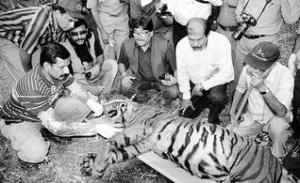 An
investigation into a tiger death in progress in Mudumalai Tiger Reserve. An
investigation into a tiger death in progress in Mudumalai Tiger Reserve.
Credit : The Hindu
Wild tigers continue to be threatened by innumerable factors ; but tiger death statistics alone cant quantify these threats.
|